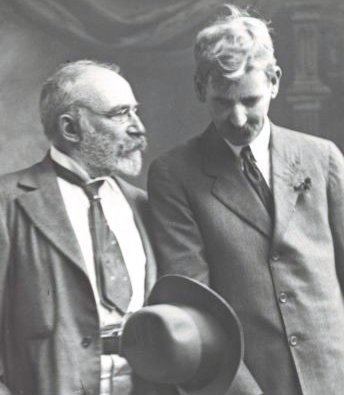 | ||
The "Bulletin Debate" was a famous dispute in The Bulletin magazine from 1892-93 between two of Australia's most iconic writers and poets: Henry Lawson and Andrew Barton "Banjo" Paterson.
Contents
Origin
At the time, The Bulletin was a popular and influential publication, and often supported the typical national self-image held by many Australians, sometimes termed the "bush legend." Many Australian writers and poets, such as "Banjo" Paterson, were based primarily in the city, and had a tendency to romanticise bush life.
On 9 July 1892, Lawson published a poem in The Bulletin entitled "Up The Country". In this poem (beginning with the verse "I am back from up the country—very sorry that I went,—"), Lawson attacked the typical "romanticised" view of bush life.
Paterson's response
On 23 July 1892, Paterson published his reply to Lawson's poem, titled "In Defense of the Bush". Whilst Lawson had accused writers such as Paterson of being "City Bushmen", Paterson countered by claiming that Lawson's view of the bushlife was full of doom and gloom. He appropriately finished his poem with the line "For the bush will never suit you, and you'll never suit the bush." Other Australian writers, such as Edward Dyson, also later contributed to the debate.
In 1939, Banjo Paterson recalled his thoughts about the Bulletin debate:
Henry Lawson was a man of remarkable insight in some things and of extraordinary simplicity in others. We were both looking for the same reef, if you get what I mean; but I had done my prospecting on horseback with my meals cooked for me, while Lawson has done his prospecting on foot and had had to cook for himself. Nobody realized this better than Lawson; and one day he suggested that we should write against each other, he putting the bush from his point of view, and I putting it from mine.
"We ought to do pretty well out of it," he said. "We ought to be able to get in three or four sets of verses before they stop us."
Cultural significance
The Bulletin Debate was followed closely by widespread readers of the publication, reinforcing the Bush as a significant part of Australia's national identity.
There was never any clear "winner" to this debate. However, Paterson presented Australia with the desired image of its national identity, and his short story collections received spectacular sales. In 1993, Paterson replaced Lawson as the poet depicted on the Australian ten-dollar note.
It is somewhat curious that, despite their vastly differing perspectives on Australian bush life, both Lawson and Paterson are often mentioned alongside each other as Australia's most iconic and influential writers.
Criticisms
The Debate did not pass without receiving criticism in regards to its attempts to define Australia's national identity. One British reviewer of the 1890s declared:
The delusion these writers [of 'The Bulletin' school] labour under is trying to be too exclusively Australian, by which they come merely provincial. That a man's lot should be cast in the wilds of Australia is no reason that his whole inner life should be taken up with the glorification of shearers or the ridicule of jackaroos. And a genuine Australian poetry can only arise when such matters fall into their true place and assume their relatively small artistic importance.
Tony Moore, in his 1997 paper about bohemian culture, says:
The bohemian traits revered by 'The Bulletin' writers are almost a caricature of the Australian national type propagated by the journal: mateship and blokey bonding to the exclusion of family life; hostility to religion, personified by the Protestant wowser; ironic humour; a fondness for alcohol, pubs and gambling; pre-occupation with a free-wheeling Australian identity (overlaid with francophilia and Irish nationalism) invariably opposed to a conservative Englishness; and an occasional flirtation with political causes such as socialism and republicanism. The identification of the bohemian with male mateship remains a strong thread in the Australian tradition, but one contested by women like Mary Gilmore in the 1890s, Dulcie Deamer in the 1920s, Joy Hester in the 1940s and Germaine Greer in the 1960s.
